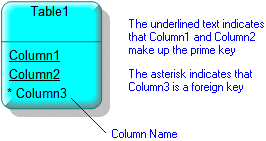Column (dictionary item)

For automation interface information about a Column, see
Column (automation interface).
A Column of a Database Table.
You can create a Column through the context menu of a Table, and through the Table Relationships Diagram.
You can use Storage Mapper to create Tables from Classes defined in the model. Storage Mapper creates a Column for each Attribute of a Class. For more information about Storage Mapper, see
Storage mapping overview (Storage Mapper).
When used on a Table Relationships Diagram, a Column's notation is as follows:

On a Table Relationships Diagram the View Options for a Table allow you to show or hide its Columns.
If you select the Proprietary\Columns folder in the Dictionary pane, the Contents pane displays the following information about each Column in the model: Data Type, Prime, Unique and Table. |
The following sections provide information about how a Column is used in the model. For more information about a property, item, model part or diagram, click it.
Properties
In addition to the standard properties, a Column has these properties:
Owned by
Owns
 Dependency — The Dependency is owned jointly by the Column and the other associated item. The access permissions you have to a Dependency are determined by the access permissions of the dependent item.
Dependency — The Dependency is owned jointly by the Column and the other associated item. The access permissions you have to a Dependency are determined by the access permissions of the dependent item.Defined in these parts of the model
Shown on these diagrams
For information about how the View Options affect the presentation of Columns, see
Table view options - table relationship diagram.
Can be linked to these dictionary items
 on the Column's icon indicates that the item is a
on the Column's icon indicates that the item is a
 Table
Table Comment
Comment Constraint
Constraint Data Model
Data Model Table Relationships Diagram
Table Relationships Diagram Variant Diagram
Variant Diagram Index
Index Stereotype
Stereotype